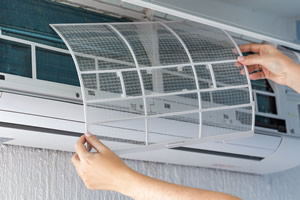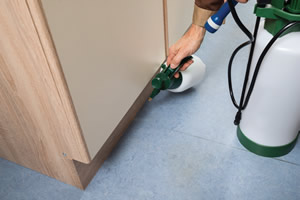Healthy Buildings and IAQ

PHOTO © PHOTOPIXEL
Taking care of buildings has always been one
of the more mundane aspects of institutional management.
But that doesn’t mean this responsibility isn’t important,
especially when it comes to health and safety. And given
today’s focus on sustainability, the need to act in an environmentally
friendly manner is paramount.
“Students and their families expect campus buildings to be
healthy environments much in the same way they expect the campus
grounds to be safe,” says Jennifer deHart, chief sustainability officer
at Maine’s Unity College. At the same time, colleges and universities
are intrinsically motivated to maintain healthy indoor environments
given their effect on perceptions of prospective students, families
and enrolled students. Healthy indoor environments also reduce risk
and support an optimum learning environment.
“Mitigating mold, pests, asbestos and other hazards can be
costly and disruptive,” she says. “Most importantly, our institutions
recognize that healthy indoor environments are better for learning
and working, resulting in fewer distractions and sick days.”
AN IAQ CHECKLIST
At SUNY Geneseo, measures taken to prevent poor indoor air
quality include the following:
- Ventilation is monitored and adjusted as necessary by facilities staff to
maintain appropriate air exchanges per hour.
- Maintenance is performed monthly on air-handling units.
- Chemicals used by custodial staff are all green or have NFPA 704 ratings
of 0 (hazard no greater than ordinary material) or 1 (may cause
irritation).
- Custodial staff are trained on use and amounts of chemical usage.
- Concentrated chemicals used by custodial staff are diluted per national
industry standards.
- Spills of products are cleaned up immediately, and staff respond to odor
complaints and perform indoor air quality investigations as necessary.
Prevention
To the degree possible, prevention may the wisest strategy.
“Since it’s extremely costly to remove hazardous contaminants
from the air we breathe, the best practice is to avoid contaminating
it in the first place,” says Al Niemi, director of occupational
safety and health services at Michigan Technological University in
Houghton. He notes that in commercial and institutional buildings,
contaminants come from the building materials themselves,
from heating and cooling equipment and from occupant activities,
including materials stored and used during those activities.

PHOTO © MR TWISTER
“Minimizing contaminants from all of these sources begins with a
careful hazard analysis and risk management decisions that are
documented and followed, whether it be during building construction
or during operation,” he says. “Elimination of noncritical
construction materials that have known health risks, and substitution
with less harmful materials for materials that cannot be
eliminated, are examples of construction decisions.”
Prevention may be more readily achievable with mold than with
many other threats. According to deHart, this might include finding
and eliminating sources of moisture infiltration or condensation.
Strategies include weather-sealing the building exterior, repairing
rainwater systems to get water away from the building and
foundation, and tuning the HVAC system to reduce humidity in the
system and resolve condensation issues. Too, indoor spaces prone to
moisture, such as bathrooms, locker rooms and below-grade spaces,
should be constructed or retrofitted with mold resistant materials.
She notes that small areas of mold can be killed using white vinegar,
essential oils or borax, but the process is labor intensive. “Mold
on a large scale should be managed by professionals,” deHart says.
“Conventional mold remediation involves toxins such as chlorine
bleach and fungicides but fortunately, green alternative products do
exist at the commercial scale, and should be requested.”

PHOTO © ANDREY_POPOV
Pests
Dealing with pests can be more complicated.
“Pests come in a wide variety, and there is no simple answer,”
says Colin Booth, an associate at Sasaki, a Massachusetts-based
planning and design firm. “However, tighter envelopes can go a
long way.” Ultimately, he says, the “green” solution is to not use
pesticides that are widely sprayed throughout buildings, despite
this being the easiest and often cheapest solution, as these could
contribute to significant long-term health issues.
At the State University of New York (SUNY) at Geneseo, the use of
Integrated Pest Management (IPM) practices has been effective, according
to spokesperson David Irwin. Preventive pesticide application
is limited because the risk of pesticide exposure may outweigh the
benefits of control, but when necessary, applications are planned for
after hours and during the least amount of activity. Building ventilation
is adjusted during outside pesticide application, and indoor
measures include use of sticky traps, sealing areas where pests may
enter buildings, maintaining clean dining and food storage areas, and
removing trash and overgrown vegetation in areas near buildings.
Lead, Asbestos and Other Contaminants
Problems in dealing with lead and asbestos may be less common,
but they can be among the most serious.
“Unlike mold and pests, lead and asbestos are inert materials
that simply do not go away,” deHart says. “Where lead or asbestos
are already present in the indoor environment, such as in old
paint, tile or insulation, the priority is to limit human exposure.”
Noting that few if any environmentally friendly handling methods
exist, she says that surfaces containing asbestos or lead can be
encapsulated in place, which may be preferable and less hazardous
than stripping, grinding or blasting the materials off. Trained
professionals must conduct any lead or asbestos abatement effort.
Other contaminants also pose challenges. They include everyday
particulates such as cigarette smoke and vehicle exhaust, as well as allergens such as perfumes, pollen and dander, deHart
points out. Her campus has a no-idling policy, and smoking is
prohibited within 25 feet of all college buildings as well as at all
college-sponsored outdoor events. Other strategies she advises
include placement of filters on outdoor-air intake vents and walkoff
mats at entryways, and frequent surface cleaning. She adds that
during construction, repair and replacement, institutions should
have a policy that specifies only no- or low-VOC products.
Along with solid policies, retaining qualified staff and providing
ongoing training are also keys to progress in this area.
“The facilities department needs to have a solid working
knowledge of sources of contaminants and sustainable methods
for managing them,” deHart says. “These front-line members of
our campus community can become the green champions safeguarding
student and employee health.”
Institutional leaders must stand behind facilities staff, she
adds, and should understand the multiple benefits of healthy
indoor environments.
“Leaders must then create the conditions to support health indoor
environments,” she says. “This can be achieved through proactive
policies, purchasing standards, and resources — both financial
and human — to support green ongoing maintenance.”
A CHANGING LANDSCAPE
Changing times. That’s what Sasaki associate Colin Booth points to
when it comes to issues of sustainability. “LEED helped usher in a decade
or so of raising everyone to a certain degree of broad understanding and
speaking a common language, which influenced the design industry,
the owners and facilities community, and many others,” he says. “While
‘green’ has addressed human health for some time, the topic is only
now maturing to the point where we can begin to quantify and evaluate
healthy environments.”
Booth cites two basic trends driving this change. One is an increase
in the number of scientific studies providing hard data on the short- and
long-term effects of our environments on health and productivity.
“This underscores a key reality,” he says. “People are our greatest
assets and our greatest expenses.” As an example, he points to efforts
to reduce carbon dioxide levels in buildings that while worthwhile, can
also be very expensive.
A second trend is significant pressure in recent years for manufacturers
to disclose the chemicals involved during the manufacturing of their products.
This “transparency movement” promises to lead to higher degrees of
overall sustainability through deeper understanding of materials.
This article originally appeared in the College Planning & Management September 2016 issue of Spaces4Learning.